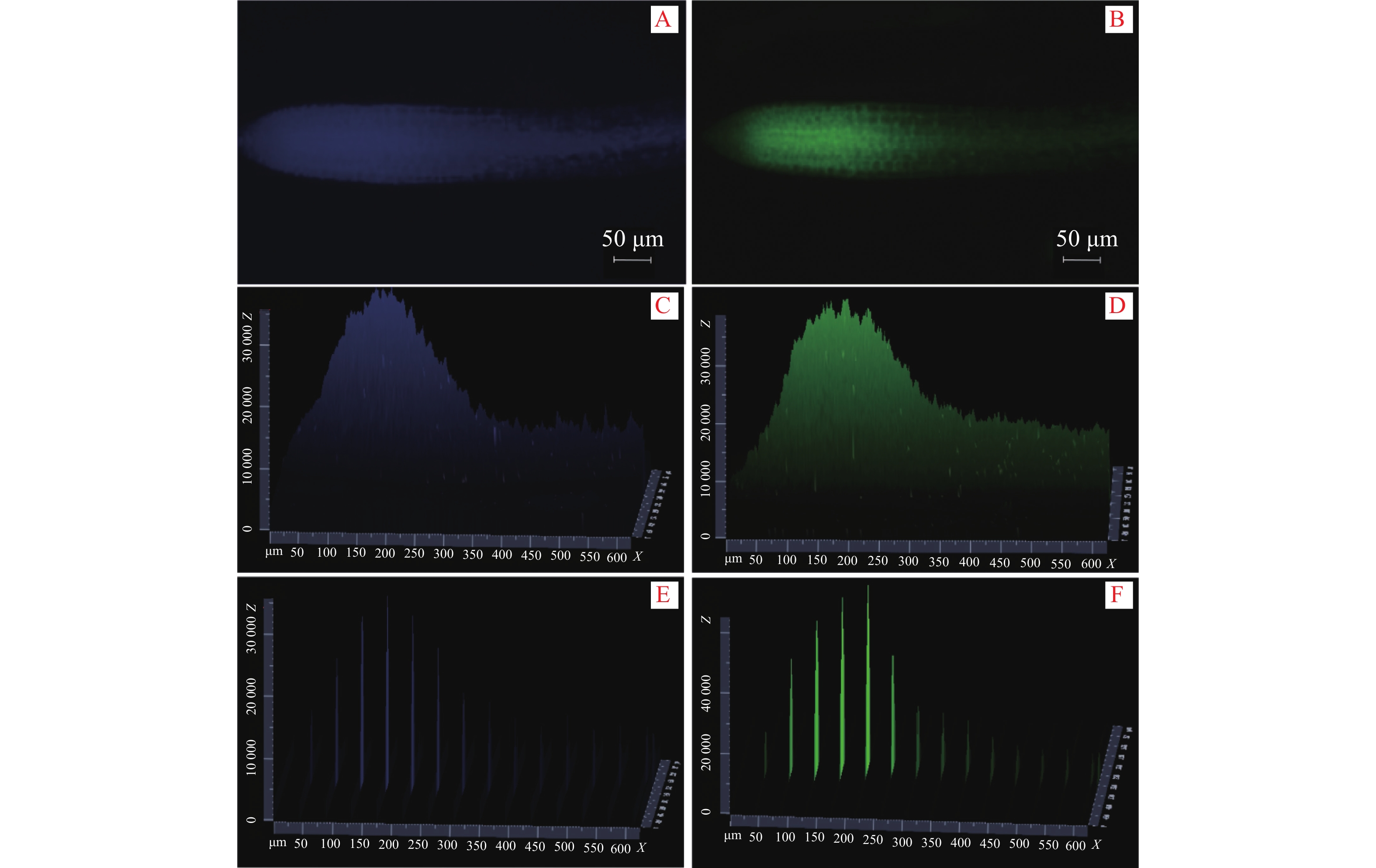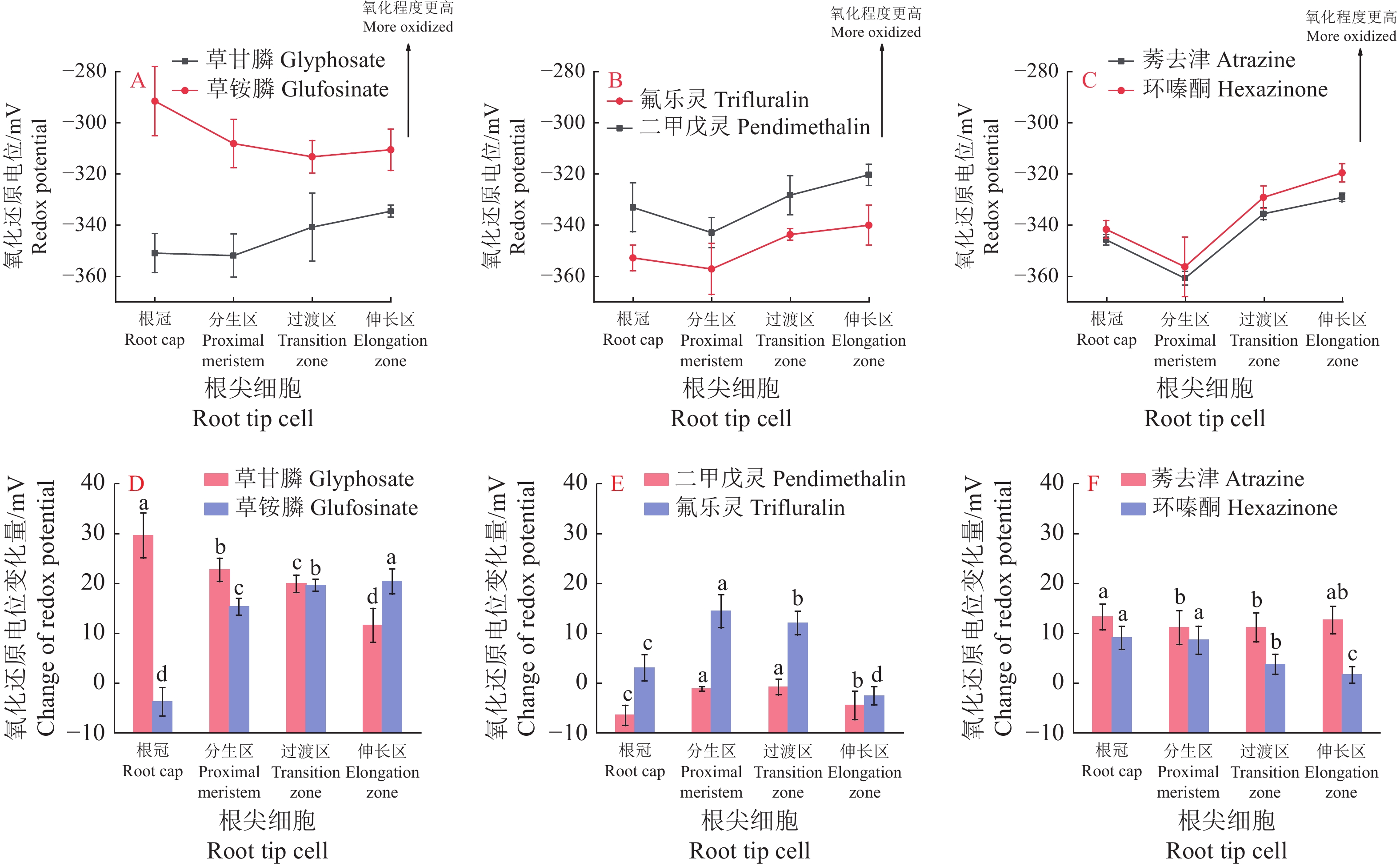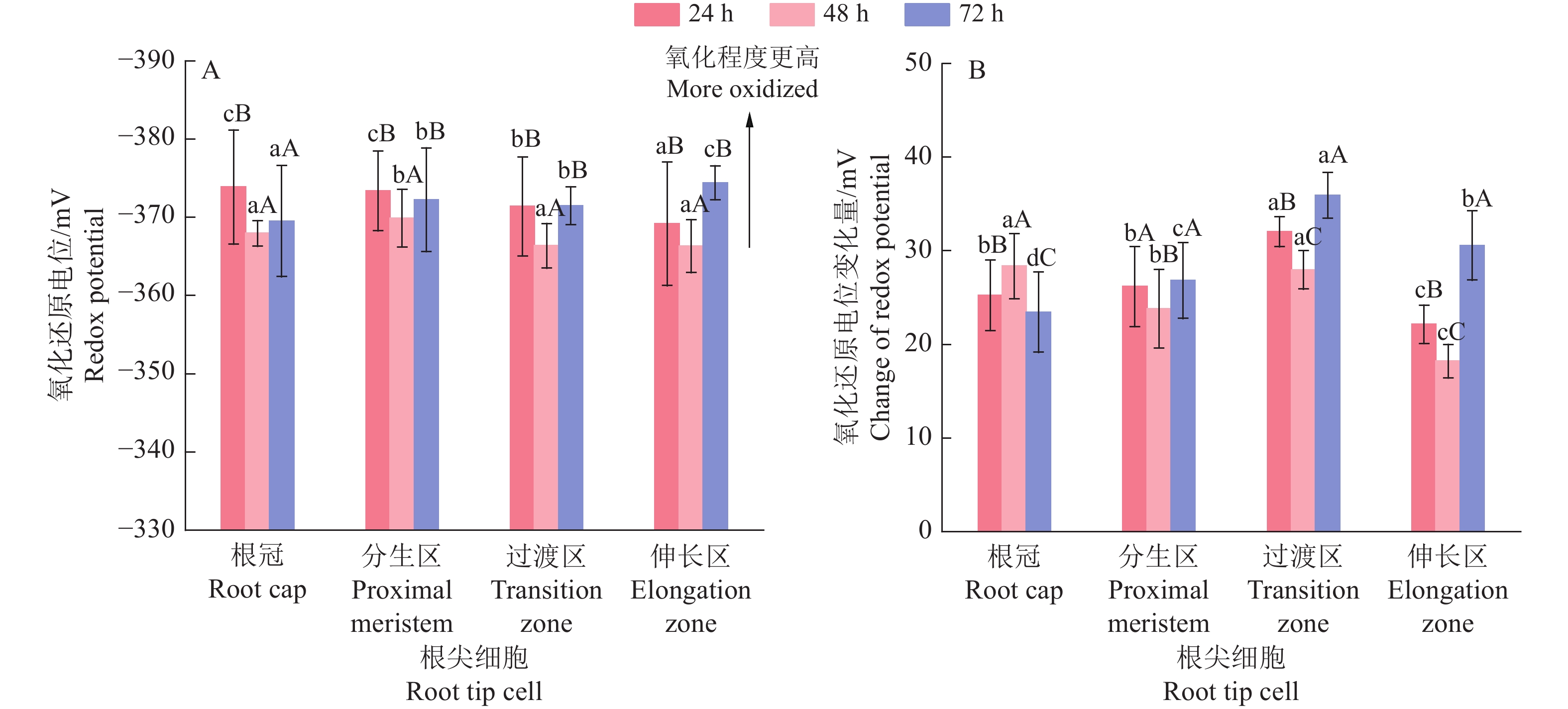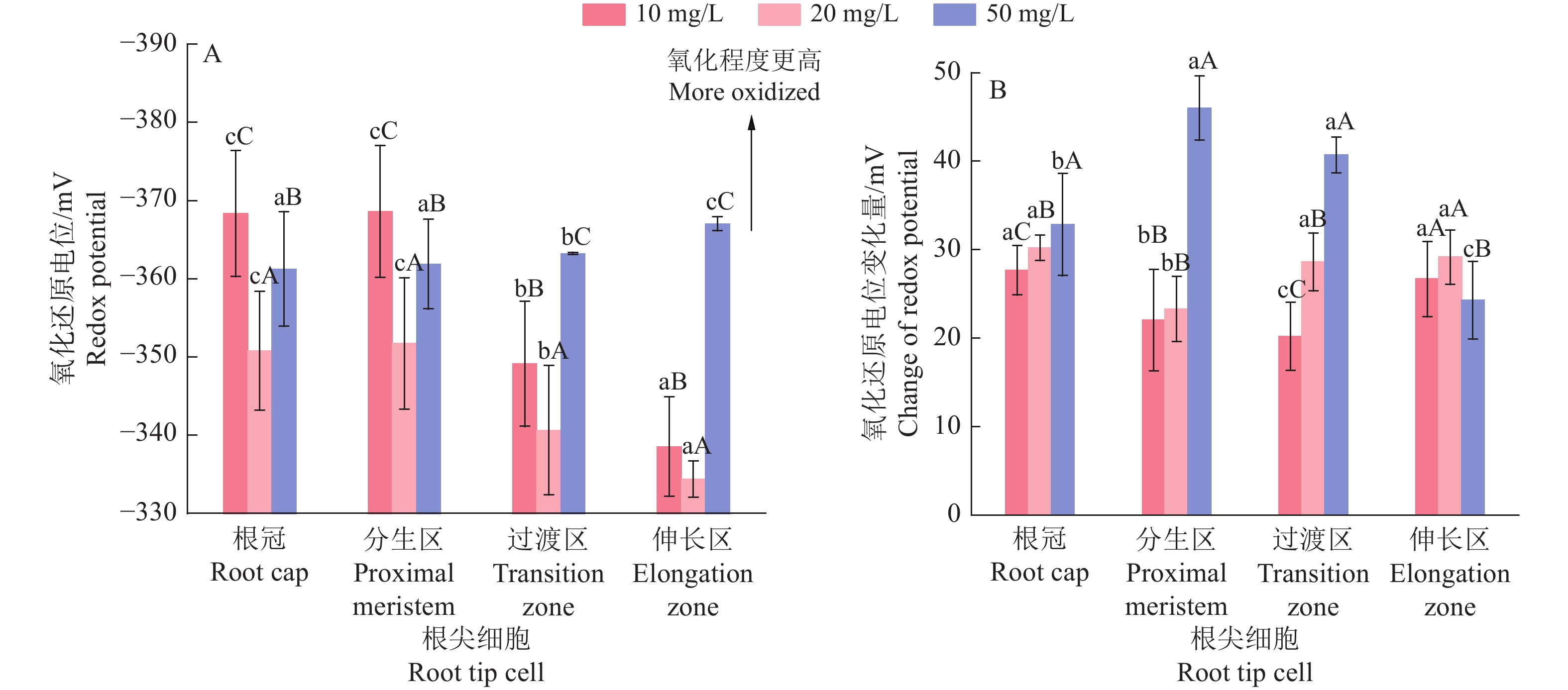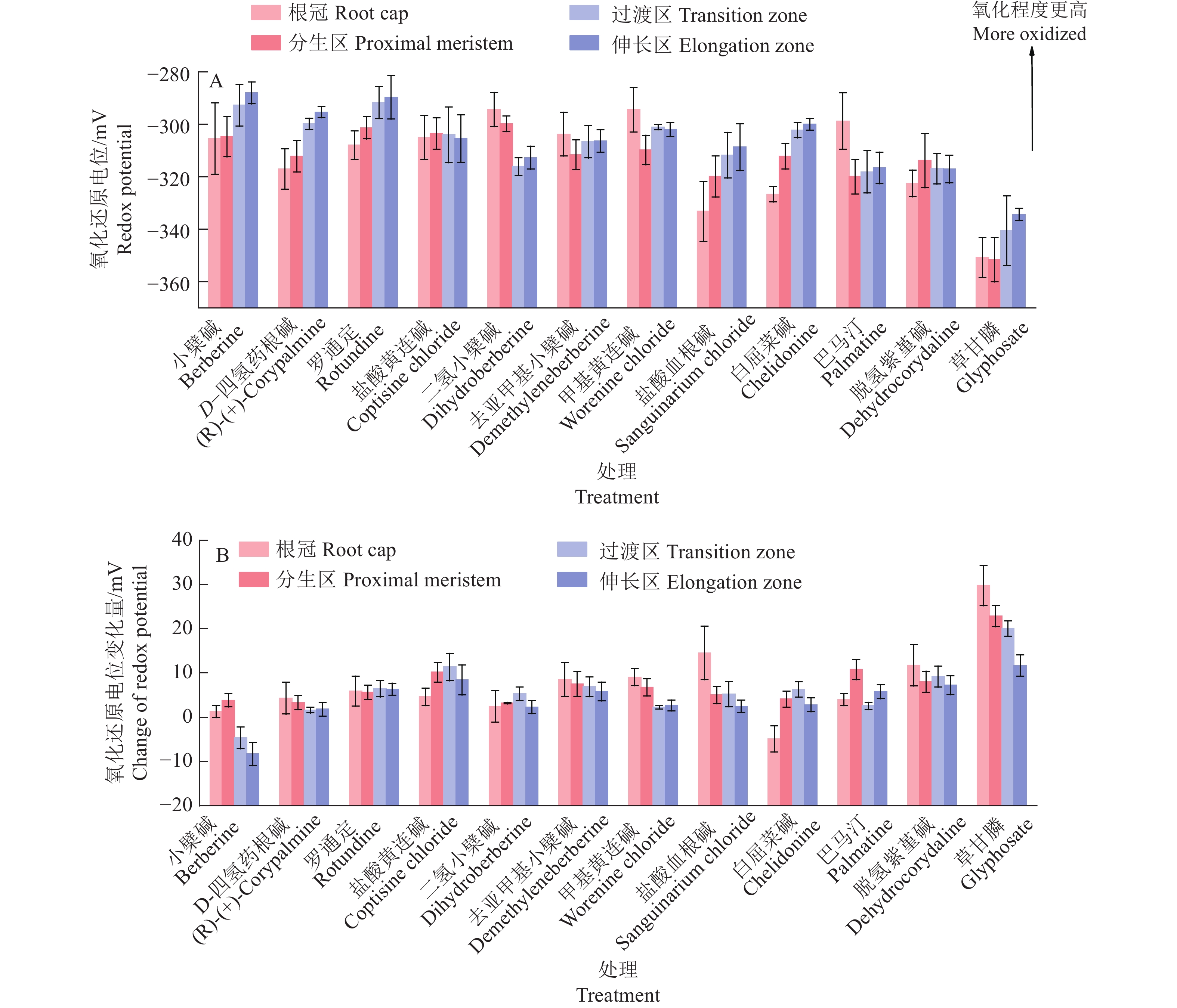Effects of herbicidal chemicals on redox potentials of Arabidopsis thaliana root tip cells based on mt-roGFP1 probe
-
摘要:目的
研究几种代表性商品化除草剂以及植物源除草化合物小檗碱及其类似物对拟南芥根尖细胞氧化还原电位的影响。
方法以靶向线粒体的氧化还原敏感绿色荧光蛋白(Mitochondria targeted redox-sensitive green fluorescent protein, mt-roGFP1)标记的拟南芥转基因植株为材料,采用不同质量浓度的化合物处理不同时间后,测定拟南芥根冠、分生区、过渡区和伸长区的细胞氧化还原电位的变化。
结果经几种商品化除草化合物处理后,拟南芥根部分生区的细胞氧化还原电位最小。从分生区到伸长区氧化还原电位逐渐增大,呈现逐渐被氧化的趋势。其中,光系统II抑制剂(莠去津和环嗪酮)的氧化还原电位变化规律最为明显,说明mt-roGFP1荧光探针能较好地响应光系统II抑制剂。氨基酸生物合成抑制剂草甘膦对拟南芥根尖细胞氧化还原的影响具有明显的剂量−效应关系,随着草甘膦质量浓度增加,氧化还原电位变化量也逐渐增大,呈正相关关系(R2 =0.9956)。小檗碱及其类似物处理后,大多数处理组的拟南芥根尖细胞的氧化还原电位在分生区达到最大还原值,并从分生区开始逐渐被氧化。
结论研究结果可以为应用roGFP荧光探针技术研究除草化合物对根系细胞线粒体的作用机制提供基础。
Abstract:ObjectiveThe aim of this study was to investigate the effects of several commercial herbicides and the botanical herbicidal compound berberine and its analogues on the redox potential of Arabidopsis thaliana root tip cells.
MethodA. thaliana transgenic plants marked with mitochondria targeted redox-sensitive green fluorescent protein were used as plant materials. The changes of cell redox potential in root cap, proximal meristem, transition zone and elongation zone were measured after being treated with different mass concentrations of herbicides for different time.
ResultThe redox potential of the proximal meristematic zone of A. thaliana root cells treated with commercial herbicides was the lowest. From the meristematic zone to the elongation zone, the redox potential gradually increased, showing a trend of being gradually oxidized. Among the tested commercial herbicides, the change rule of redox potential of photosystem II inhibitors (atrazine and hexazinone) was the most obvious, indicating that mt-roGFP1 fluorescent probe could respond better to photosystem II inhibitors. The effect of glyphosate, an amino acid biosynthesis inhibitor, on the redox potential of A. thaliana root tip cells showed an obvious dose-response manner. With the increase of mass concentration, the change of the redox potential also gradually increased, showing a positive correlation with R2=0.9956. After the treatment of berberine and its analogues, the redox potential of A. thaliana root tip cells in most treatment groups reached the maximum reduction value in the proximal meristematic zone, and was gradually oxidized from the meristematic zone.
ConclusionThese results provide a basis for applying roGFP fluorescence probe technology to studying the mechanism of herbicidal compounds acting on root cell mitochondria.
-
-
图 1 mt-roGFP1标记的拟南芥转基因植株根尖透明化(A)及荧光分区(B)
小圆直径为30 μm;RC:根冠;PM:分生区;TZ:过渡区;EZ:伸长区
Figure 1. Root tip transparency (A) and fluorescence zoning (B) of mt-roGFP1 labeled transgenic Arabidopsis thaliana plants
Small circle diameter is 30 μm; RC: Root cap; PM: Proximal meristem; TZ: Transition zone; EZ: Elongation zone
图 2 拟南芥根尖荧光强度图
A、C、E:410 nm (DAPI)通道;B、D、F:470 nm (GFP)通道;A、B: 荧光强度图;C、D: 荧光强度−高度转化图;E、F: 荧光强度−高度转化分区图
Figure 2. Fluorescence intensity diagram of root tip
of Arabidopsis thaliana A, C, E: 410 nm (DAPI) channel; B, D, F: 470 nm (GFP) channel; A, B: Fluorescence intensity diagram; C, D: Fluorescence intensity-height conversion diagram; E, F: Fluorescence intensity-height conversion zoning map
图 3 不同作用机理商品化除草剂对拟南芥根尖细胞的氧化还原电位及变化量的影响
同种除草剂处理间的不同小写字母表示不同部位差异显著(P < 0.05,Duncan’s法)
Figure 3. Effects of commercial herbicides with different action mechanisms on redox potential and its changes of Arabidopsis thaliana root tip cells
Different lowercase letters of the same herbicide among different parts indicate significant differences (P<0.05, Duncan’s method)
图 4 草甘膦不同处理时间对拟南芥根尖细胞氧化还原电位的影响
柱子上不同小写字母表示同一时间不同部位处理差异显著,不同大写字母表示同一部位不同处理时间差异显著(P < 0.05,Duncan’s法)
Figure 4. Effect of glyphosate with different treatment time on redox potential of Arabidopsis thaliana root tip cells
Different lowercase letters on the columns indicate significant differences among different parts at the same time, and different uppercase letters indicate significant differences among different treatment time of the same part (P < 0.05, Duncan’s method)
图 5 不同质量浓度草甘膦对拟南芥根尖细胞氧化还原电位变化的影响
柱子上不同小写字母表示同一质量浓度不同部位处理差异显著,不同大写字母表示同一部位不同质量浓度处理差异显著(P < 0.05,Duncan’s法)
Figure 5. Effects of different concentrations of glyphosate on redox potential of Arabidopsis thaliana root tip cells
Different lowercase letters on the columns indicate significant differences among different parts under the same mass concentration, and different upper-case letters indicate significant differences of the same part among different mass concentrations (P<0.05, Duncan’s method)
-
[1] ZENTGRAF U, ANDRADE-GALAN A G, BIEKER S. Specificity of H2O2 signaling in leaf senescence: Is the ratio of H2O2 contents in different cellular compartments sensed in Arabidopsis plants?[J]. Cellular & Molecular Biology Letters, 2022, 27(1): 4. doi: 10.1186/s11658-021-00300-w.
[2] VITIELLO G, SERPE L, BLÁZQUEZ-CASTRO A. Editorial: The role of reactive oxygen species in chemical and biochemical processes[J]. Frontiers in Chemistry, 2021, 19(9): 642523. doi: 10.3389/fchem.2021.642523.
[3] SINGH D. Juggling with reactive oxygen species and antioxidant defense system: A coping mechanism under salt stress[J]. Plant Stress, 2022, 5: 100093. doi: 10.1016/j.stress.2022.100093.
[4] CAO X L, RAO C Y, CUI H, et al. Toxic effects of glyphosate on the intestine, liver, brain of carp and on Epithelioma papulosum cyprinid cells: Evidence from in vivo and in vitro research[J]. Chemosphere, 2022, 302(9): 134691. doi: 10.1016/j.chemosphere.2022.134691.
[5] SADHUKHAN A, KOYAMA H. Role of reactive oxygen species homeostasis in root development and rhizotoxicity in plants[M]//Anon. Redox Homeostasis in Plants. Cham, Switzerland: Springer, 2019: 117-136.
[6] BOGUSZEWSKA D, ZAGDAŃSKA B. ROS as signaling molecules and enzymes of plant response to unfavorable environmental conditions[M]// IntechOpen. Oxidative stress: Molecular mechanism and biological effects. London: lntechOpen. 2012. doi: 10.13140/2.1.1368.6724.
[7] BAXTER A, MITTLER R, SUZUKI N. ROS as key players in plant stress signalling[J]. Journal of Experimental Botany, 2014, 65(5): 1229-1240. doi: 10.1093/jxb/ert375
[8] CZARNOCKA W, KARPIŃSKI S. Friend or foe? Reactive oxygen species production, scavenging and signaling in plant response to environmental stresses[J]. Free Radical Biology and Medicine, 2018, 122: 4-20. doi: 10.1016/j.freeradbiomed.2018.01.011
[9] ROSENWASSER S, ROT I, SOLLNER E, et al. Organelles contribute differentially to reactive oxygen species-related events during extended darkness[J]. Plant Physiology, 2011, 156(1): 185-201. doi: 10.1104/pp.110.169797
[10] 赵晓玉, 薛娴, 卢存福, 等. 植物中活性氧信号转导及其检测方法研究进展[J]. 电子显微学报, 2014, 33(2): 188-196. doi: 10.3969/j.1000-6281.2014.02.015 [11] ORTEGA-VILLASANTE C, BURÉN S, BLÁZQUEZ-CASTRO A, et al. Fluorescent in vivo imaging of reactive oxygen species and redox potential in plants[J]. Free Radical Biology and Medicine, 2018, 122: 202-220. doi: 10.1016/j.freeradbiomed.2018.04.005
[12] PACOUD M, MANDON K, CAZARETH J, et al. Redox-sensitive fluorescent biosensors detect Sinorhizobium meliloti intracellular redox changes under free-living and symbiotic lifestyles[J]. Free Radical Biology and Medicine, 2022, 1(184): 185-195.
[13] DE CUBAS L, PAK V V, BELOUSOV V V, et al. The mitochondria-to-cytosol H2O2 gradient is caused by peroxiredoxin-dependent cytosolic scavenging[J]. Antioxidants (Basel, Switzerland), 2021, 10(5): 731. doi: 10.3390/antiox10050731.
[14] WIERER S, PETER S, ELGASS K, et al. Determination of the in vivo redox potential by one-wavelength spectro-microscopy of roGFP[J]. Analytical and Bioanalytical Chemistry, 2012, 403(3): 737-744. doi: 10.1007/s00216-012-5911-0
[15] THAO M T, RIEDEL M, ZIELONKA J, et al. Imaging the dynamic redox changes of endoplasmic reticulum with green fluorescent protein[J]. Free Radical Biology and Medicine, 2014, 76(1): S93. doi: 10.1016/j.freeradbiomed.2014.10.324.
[16] BILAN D S, BELOUSOV V V. New tools for redox biology: From imaging to manipulation[J]. Free Radical Biology and Medicine, 2017, 109: 167-188. doi: 10.1016/j.freeradbiomed.2016.12.004
[17] NORCROSS S, TRULL K J, SNAIDER J, et al. Extending roGFP emission via Förster-type resonance energy transfer relay enables simultaneous dual compartment ratiometric redox imaging in live cells[J]. ACS Sensors, 2017, 2(11): 1721-1729. doi: 10.1021/acssensors.7b00689
[18] VAN LOI V, ANTELMANN H. Method for measurement of bacillithiol redox potential changes using the Brx-roGFP2 redox biosensor in Staphylococcus aureus[J]. MethodsX, 2020, 7: 100900. doi: 10.1016/j.mex.2020.100900.
[19] HATORI Y, KUBO T, SATO Y, et al. Visualization of the redox status of cytosolic glutathione using the organelle- and cytoskeleton-targeted redox sensors[J]. Antioxidants (Basel, Switzerland), 2020, 9(2): 129. doi: 10.3390/antiox9020129.
[20] MCLACHLAN D H. New tools for monitoring hydrogen peroxide in Arabidopsis[J]. The New Phytologist, 2019, 221(3): 1180-1181. doi: 10.1111/nph.15616
[21] MEYER A J, DICK T P. Fluorescent protein-based redox probes[J]. Antioxidants & Redox Signaling, 2010, 13(5): 621-650.
[22] ALLER I, ROUHIER N, MEYER A J. Development of roGFP2-derived redox probes for measurement of the glutathione redox potential in the cytosol of severely glutathione-deficient rml1 seedlings[J]. Frontiers in Plant Science, 2013, 4: 506. doi: 10.3389/fpls.2013.00506.
[23] AI H W. Fluorescent-protein-based probes: General principles and practices[J]. Analytical & Bioanalytical Chemistry, 2015, 407(1): 9-15.
[24] FAN Y C, AI H W. Development of redox-sensitive red fluorescent proteins for imaging redox dynamics in cellular compartments[J]. Analytical and Bioanalytical Chemistry, 2016, 408(11): 2901-2911. doi: 10.1007/s00216-015-9280-3
[25] HORVÁTH E, BELA K, HOLINKA B, et al. The Arabidopsis glutathione transferases, AtGSTF8 and AtGSTU19 are involved in the maintenance of root redox homeostasis affecting meristem size and salt stress sensitivity[J]. Plant Science, 2019, 283: 366-374. doi: 10.1016/j.plantsci.2019.02.005
[26] 邝芷琪, 王少婷, 黄伦, 等. 小檗碱的农用活性研究进展[J]. 农药, 2017, 56(2): 88-93. doi: 10.16820/j.cnki.1006-0413.2017.02.003 [27] 周利娟, 黄继光, 徐汉虹. 小檗碱作为除草剂的应用: CN102349520A[P]. 2013-09-04. [28] SABATINI S, BEIS D, WOLKENFELT H, et al. An auxin-dependent distal organizer of pattern and polarity in the Arabidopsis root[J]. Cell, 1999, 99(5): 463-472. doi: 10.1016/S0092-8674(00)81535-4
[29] JIANG K N, SCHWARZER C, LALLY E, et al. Expression and characterization of a redox-sensing green fluorescent protein (reduction-oxidation-sensitive green fluorescent protein) in Arabidopsis[J]. Plant Physiology, 2006, 141(2): 397-403. doi: 10.1104/pp.106.078246
[30] SCHWARZLÄNDER M, FRICKER M D, MÜLLER C, et al. Confocal imaging of glutathione redox potential in living plant cells[J]. Journal of Microscopy, 2008, 231(2): 299-316. doi: 10.1111/j.1365-2818.2008.02030.x
[31] ROMA L P, DEPONTE M, RIEMER J, et al. Mechanisms and applications of redox-sensitive green fluorescent protein-based hydrogen peroxide probes[J]. Antioxidants & Redox Signaling, 2018, 29(6): 552-568. doi: 10.1089/ars.2017.7449
[32] MOSELER A, DHALLEINE T, ROUHIER N, et al. Arabidopsis thaliana 3-mercaptopyruvate sulfurtransferases interact with and are protected by reducing systems[J]. The Journal of Biological Chemistry, 2021, 296: 100429. doi: 10.1016/j.jbc.2021.100429.
[33] CHANDRASEKHARAN A, VARADARAJAN S N, LEKSHMI A, et al. A high-throughput real-time in vitro assay using mitochondrial targeted roGFP for screening of drugs targeting mitochondria[J]. Redox Biology, 2019, 20: 379-389. doi: 10.1016/j.redox.2018.10.013
[34] JIANG K N, MOE-LANGE J, HENNET L, et al. Salt stress affects the redox status of Arabidopsis root meristems[J]. Frontiers in Plant Science, 2016, 7: 81. doi: 10.3389/fpls.2016.00081.
[35] WU J, MA J J, LIU B, et al. Herbicidal spectrum, absorption and transportation, and physiological effect on Bidens pilosa of the natural alkaloid berberine[J]. Journal of Agricultural and Food Chemistry, 2017, 65(30): 6100-6113. doi: 10.1021/acs.jafc.7b01259



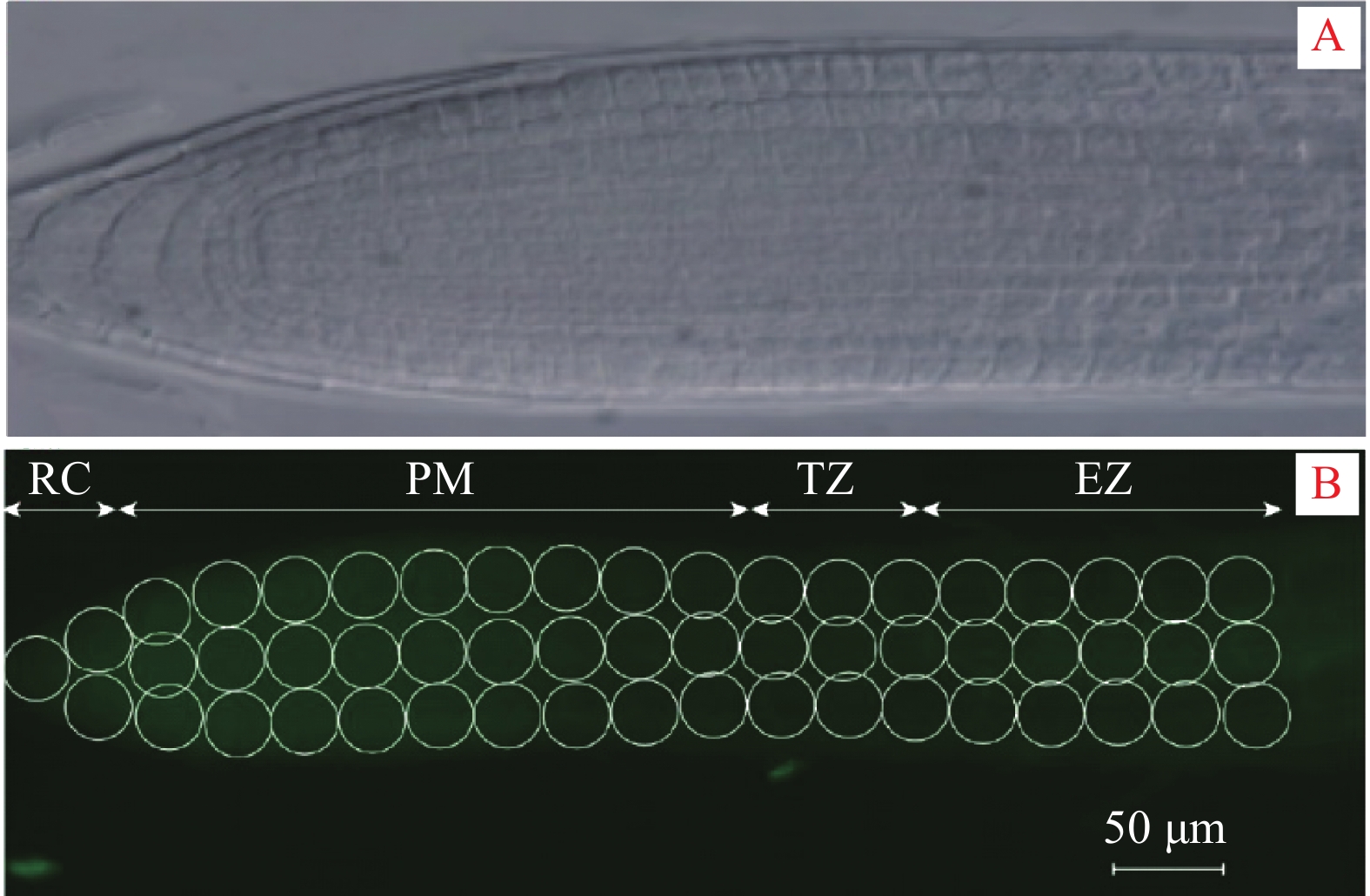
 下载:
下载:
